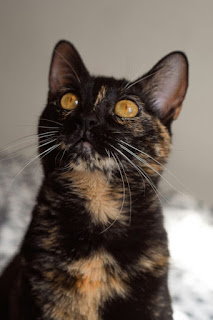Scientists have spend more than 60 years unsuccessfully trying to find the gene that causes orange fur and the patchwork of colors in calicos and tortoiseshells. Two different studies found finally the mutation and discovered the protein that influence this mutation. Tortoiseshell and calico cats are the offspring of a black cat and an orange cat. The multicolored cats are mostly female suggesting that chromosomes X is the responsible. Female cats inherit a X chromosome from each parents but during embryonic formation cells would need only an X chromosome and will choose randomly which one to express. The other X chromosome will inactivate. So tortoiseshell fur depends on which chromosome was inactivated in difference part of the skin. Calico adds to this already particular situation the withe fur which through another genetic mechanism shut down pigment production.
In most mammals red hair is cause by a mutation of the surface protein Mc1r that determines if melanocytes needs to produce a dark pigment or the lighter red-yellow pigment for skin and/or hair. If the protein Mc1r is less active the red or blonde hair will occur. Unfortunately this mutation didn’t seem to explain why cats had orange fur since the protein and the mutation are not located on the X chromosome. A team led from Greg Barsh, collected samples of red fur from cats fetuses and measured how the skin cells express the gene and the color by measuring the amount of RNA that each melanocyte produced. Turned out that the melanocytes from the orange cats produced 13 times more RNA from a gene called Arhgap36. The gene is located on the X chromosome which led to think that this was the responsible. The DNA sequence of the Arhgap36 protein shown not a mutation on the gene but a deletion of part of DNA that doesn’t affect directly the protein but that is involved in regulating how much it produced. Searches on genetic databases have shown that every single orange, calico and tortoiseshell cat have this particular mutation. The discovery was preprint on the server bioRxiv.
A separate study from Japan confirmed this theory. 24 feral japan cats and 258 cat genome around the world revealed the same genetic deletion. Moreover, researchers also found that calico cats have more Arhgap36 in the orange regions compared to the black and brown ones. It has also discovered that the gene is subject to X inactivation since it silences one of the two X chromosome in females. The two team respectively found out that the increase level of Arhgap36 in melanocytes activate another way for the cell to produce the red pigment regardless if the MC1r is active or not. This discovery is very interesting because it is unusual that a deletion instead of a mutation makes a gene more active rather than less. Moreover, the discovery of a new molecular pathways for hair color it was unheard and unexpected but shine a light on how complex is gene expression. This discovery also prove once again how RNA have a crucial role in controlling gene regulation and expression of different phenotypes.


What’s surprising about this discovery is that a deletion, instead of a mutation, made the Arhgap36 gene more active. Usually, deletions reduce gene activity, so this is unusual. It also shows how complex gene expression can be and how important RNA is in controlling traits like fur color.
ReplyDelete